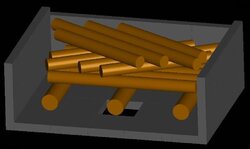We all (may) know several methods to start a fire. "Top Down", with kindling stacked on top of increasingly larger pieces of wood with the largest on the bottom, has been around a while and is recently more in vogue. In fact, mostly because it's engineered with larger pieces on the bottom which makes collapsing less likely and it starts hot with the smaller pieces igniting first, I like it and have used it routinely since learning about it a few years ago with inside heating appliances and outside campfires. Nary a problem. As long as the wood is dry and air space is left between pieces (and, outside, if it's not too windy), it starts.
One thing I've learned, though, (mostly, in life) is that "things change". And, sure enough, my use of the "Top Down" method of fire starting is one of those things.
For lack of a better name, I call it "Inside Out Fire Starting". Why and how follows.
When placing wood in the firebox in the usual "top down" largest pieces on the bottom method, the (necessary for air) spaces created between pieces gave me the idea to honor this space a bit more with smaller kindling starting lower down. The next layer up, placed perpendicular to the first, is made with the honored space and more kindling directly above the previous layer. And so on with perpendicular layers for as high as you stack your particular appliance firebox. The result is a "kindling containing vertical column" in the approximate middle of the normally stacked firebox. Then, one (homemade) firestarter is placed in the lowest airspace on top of some kindling and ignited. The kindling directly above the firestarter ignites very rapidly and likewise spreads upward to the kindling above it.
There is no wondering, as in the pure "top down" method, if you have enough kindling or if the thing is really going to start or not. It starts with a vengence, believe me. And, there is no collapsing since the main support is engineered "top down", largest pieces on the bottom. The fire starts "inside" the main stacked load, burns and is consumed upward toward the "outside" of the stack; hence "Inside Out".
Try it.
Aye,
Marty
Grandma used to say, "Work smarter, not harder."
One thing I've learned, though, (mostly, in life) is that "things change". And, sure enough, my use of the "Top Down" method of fire starting is one of those things.
For lack of a better name, I call it "Inside Out Fire Starting". Why and how follows.
When placing wood in the firebox in the usual "top down" largest pieces on the bottom method, the (necessary for air) spaces created between pieces gave me the idea to honor this space a bit more with smaller kindling starting lower down. The next layer up, placed perpendicular to the first, is made with the honored space and more kindling directly above the previous layer. And so on with perpendicular layers for as high as you stack your particular appliance firebox. The result is a "kindling containing vertical column" in the approximate middle of the normally stacked firebox. Then, one (homemade) firestarter is placed in the lowest airspace on top of some kindling and ignited. The kindling directly above the firestarter ignites very rapidly and likewise spreads upward to the kindling above it.
There is no wondering, as in the pure "top down" method, if you have enough kindling or if the thing is really going to start or not. It starts with a vengence, believe me. And, there is no collapsing since the main support is engineered "top down", largest pieces on the bottom. The fire starts "inside" the main stacked load, burns and is consumed upward toward the "outside" of the stack; hence "Inside Out".
Try it.
Aye,
Marty
Grandma used to say, "Work smarter, not harder."



